20th Century Fox (also Twentieth Century Fox or simply Fox) was one of the ‘Big Six’ major American film studios (with Paramount, Warner Bros., Universal, Columbia, and Disney). In 1935, it was formed from the merger of Fox Film and Twentieth Century Pictures. In 1953, 20th Century–Fox introduced CinemaScope, and The Robe (1953) started the trend of wide screens in cinemas. 20th Century–Fox also brought Marilyn Monroe to stardom. Among the studio’s most successful musicals were The King and I (1956) and South Pacific (1958). Later followed such hits as The Sound of Music (1965), Star Wars (1977) and Avatar (2009). Since 2013 the studio has been a subsidiary of 21st Century Fox, which merged in 2018 with Disney.
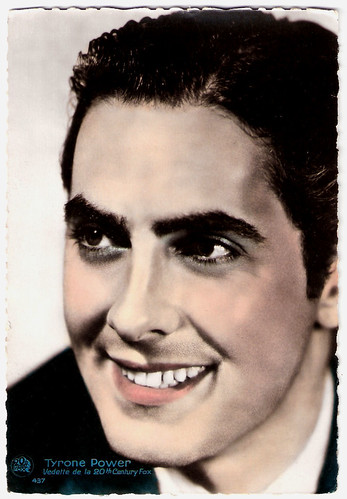
Tyrone Power. French postcard, no. 437. Photo: 20th Century Fox.
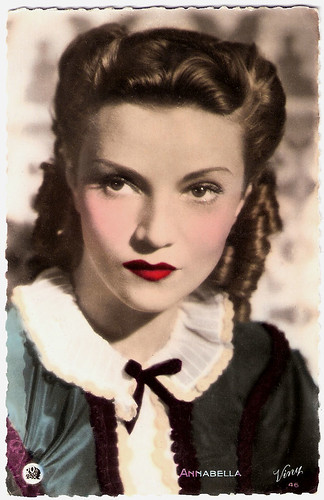
Annabella. French postcard by Viny, no. 46. Photo: 20th Century Fox.
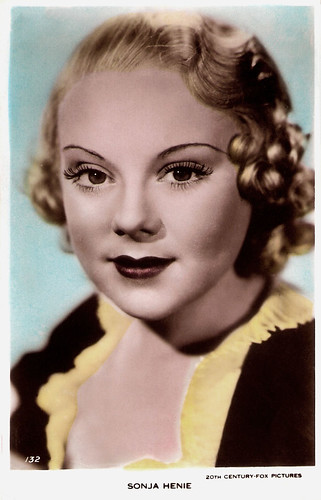
Sonja Henie. British Postcard by Real Photograph, no. 132. Photo: 20th Century-Fox Pictures.

Simone Simon. British Postcard in the Art Photo series, no. 37-2. Photo: 20th Century Fox, no. 135.

Richard Greene. French postcard by Viny, no. 89. Photo: 20th Century Fox.
For many years, 20th Century Fox claimed to have been founded in 1915, the year Fox Film was founded by pioneer William Fox. For instance, it marked 1945 as its 30th anniversary. However, in recent years it has claimed the 1935 merger as its founding, even though most film historians agree it was founded in 1915. 20th Century Fox is known for its searchlight structure logo. Its fanfare was originally composed in 1933 for Twentieth Century Pictures by Alfred Newman, who would become the head of Twentieth Century-Fox's music department from 1940 until the 1960s. It was re-recorded in 1935 when 20th Century-Fox was officially established.
In the early spring of 1935, Twentieth Century Pictures' Joseph Schenck and Darryl F. Zanuck began merger talks with the management of the nearly bankrupt Fox Film, under President Sidney Kent. Spyros Skouras, then manager of the Fox West Coast Theatres, helped make the merger happen, and later became president of the new company. Aside from the theatre chain and a first-rate studio lot, Zanuck and Schenck felt there was not much else to Fox, which had been reeling since the founder William Fox lost control of the company in 1930. The studio's biggest star, Will Rogers, died in a plane crash weeks after the merger. Its leading female star, Janet Gaynor, was fading in popularity and promising leading men James Dunn and Spencer Tracy had been dropped because of heavy drinking.
At first, it was expected that the new company was originally to be called Fox-20th Century, even though 20th Century was the senior partner in the merger. However, 20th Century brought more to the bargaining table besides Schenck and Zanuck; it was more profitable than Fox and had considerably more talent. So, the new Hollywood powerhouse, 20th Century-Fox Film Corporation, began trading on 31 May 1935. The hyphen would be dropped in 1985. Kent remained as President, while Schenck became Chairman and Chief Executive Officer. Zanuck became Vice President in Charge of Production. The company's films retained the 20th Century Pictures searchlight logo on their opening credits as well as its opening fanfare, but with the name changed to 20th Century-Fox.
After the merger was completed, Darryl F. Zanuck brought three stars with him: George Arliss and Loretta Young, from Warners, and Constance Bennett, and he quickly signed young actors who would carry Twentieth Century-Fox for years: Tyrone Power, Linda Darnell, Carmen Miranda, Don Ameche, Henry Fonda, Gene Tierney, and Olympic skater Sonja Henie. Also on the Fox payroll he found two players who he built up into the studio's leading assets, Alice Faye and seven-year-old Shirley Temple. The company established a special training school. Lynn Bari and Patricia Farr were among 14 young women launched for stardom in 1935, when they each received a six-month contract with 20th Century-Fox after spending 18 months in the school. The contracts included a studio option for renewal for as long as seven years. Favouring popular biographies and musicals, Zanuck built Fox back to profitability with light entertainment like Alexander's Ragtime Band (Henry King, 1938) and In Old Chicago (Henry King, 1938), both starring Tyrone Power, Alice Faye and Don Ameche. Twentieth Century–Fox produced mainly Westerns, biopics, religious epics and musicals. The company’s early musicals featured Shirley Temple, but Zanuck was never terribly fond of curly-topped Temple in spite of her enormous popularity.
Leonard Maltin in The Hollywood Reporter: “Zanuck wouldn't have survived in the #MeToo or Time's Up era. He was notorious for taking advantage of starlets. In early 1942, the wiry workaholic, then 40, wangled a commission as a colonel in the U.S. Army Signal Corps and surprised everyone by displaying a hunger to see action. When he returned to Hollywood in mid-1943, he revealed a renewed interest in serious-minded movies, first evidenced in such standout films as Young Mr. Lincoln and The Grapes of Wrath, both directed by John Ford.”
Thanks to record attendance during World War II, Fox overtook RKO and Metro-Goldwyn-Mayer (Hollywood's biggest studio) to become the third most profitable film studio. In 1942, Spyros Skouras succeeded Kent as president of the studio. While Zanuck went off for eighteen months' war service, junior partner William Goetz kept profits high by going for light entertainment. Zanuck always had someone waiting in reserve in case one of his stars became uncooperative. Betty Grable was hired as a threat to musical star Alice Faye and soon surpassed her as Fox's premier attraction and No. 1 pinup. The creamy blonde Grable was 20th Century-Fox’s biggest star of the 1940s.
Together with Skouros, Darryl F. Zanuck intended to make Fox's output more serious-minded. During the next few years, with pictures like The Razor's Edge (Edmund Goulding, 1946) with Tyrone Power as an American pilot traumatised by his experiences in World War I, Gentleman's Agreement (Elia Kazan,1947) with Gregory Peck as a journalist, who poses as a Jew to research an exposé on anti-Semitism, The Snake Pit (Anatole Litvak, 1948) starring Olivia de Havilland as a woman who finds herself in an insane asylum and cannot remember how she got there, and the race drama Pinky (Elia Kazan, 1949), with Jeanne Crain as an African-American girl passing for white. Zanuck established a reputation for provocative, adult films. Despite such successes, however, the studio’s productions were often criticized for lacking the style and excitement of films made by rival studios, notably Warner Brothers and MGM.
Fox specialised in adaptations of best-selling books such as Ben Ames Williams' Leave Her to Heaven (John M. Stahl, 1945), starring Gene Tierney as a femme fatale who entraps a husband (Cornel Wilde) and commits several crimes motivated by her insane jealousy over everything concerning him. Tierney received an Oscar nomination as Best Actress. The film grossed over $5,000,000, Fox's highest-grossing picture of the 1940s. Fox also produced film versions of Broadway musicals, including the Rodgers and Hammerstein films, beginning with the musical version of State Fair (Walter Lang, 1945), starring Jeanne Crain and Dana Andrews. State Fair was the only Rodgers and Hammerstein musical written directly for film. The film introduced such popular songs as It Might as Well Be Spring, which won the Academy Award for Best Original Song.
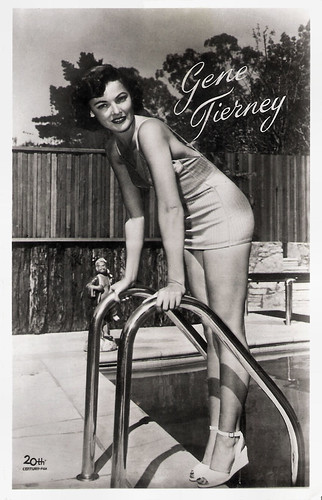
Gene Tierney. Dutch postcard. Photo: 20th Century Fox.
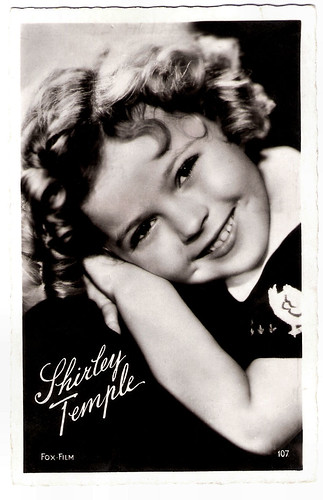
Shirley Temple. French postcard by Editions et Publications Cinématographiques, no. 107. Photo: Fox-Film.
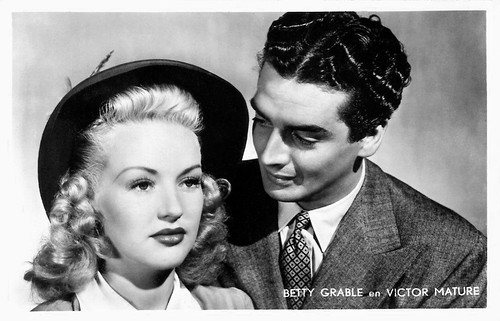
Betty Grable and Victor Mature. Dutch postcard by Uitg. J. Sleding N.V., Amsterdam, no. 33. Photo: 20th Century Fox. Publicity still for I Wake Up Screaming (H. Bruce Humberstone, 1941).
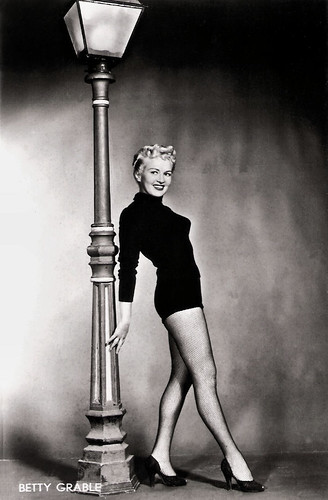
Betty Grable. Dutch postcard, no. 204. Photo: 20th Century Fox.

Cary Grant. Dutch postcard, no. 3286. Photo: 20th Century Fox. Publicity still for I Was a Male War Bride (Howard Hawks, 1949).
After the war, and with the advent of television, audiences slowly drifted away. Twentieth Century-Fox held on to its theatres until a court-mandated ‘divorce’; they were spun off as Fox National Theatres in 1953.That year, with attendance at half the 1946 level, Twentieth Century-Fox gambled on an unproven gimmick. Noting that the two film sensations of 1952 had been Cinerama, which required three projectors to fill a giant curved screen, and Natural Vision 3D, which got its effects of depth by requiring the use of polarised glasses, Fox mortgaged its studio to buy rights to a French anamorphic projection system which gave a slight illusion of depth without glasses. President Spyros Skouras struck a deal with the inventor Henri Chrétien, leaving the other film studios empty-handed. He introduced CinemaScope, a process by which a film is projected on a screen two and a half times as wide as it is high, in The Robe (Henry Koster, 1953). This ground-breaking Biblical Epic tells the story of a Roman military tribune (Richard Burton) who commands the unit that is responsible for the Crucifixion of Jesus.
Zanuck announced in February 1953 that henceforth all Fox pictures would be made in CinemaScope. To convince theatre owners to install this new process, Fox agreed to help pay conversion costs (about $25,000 per screen); and to ensure enough product, Fox gave access to CinemaScope to any rival studio choosing to use it. Seeing the box-office for the first two CinemaScope features, The Robe (1953) and the romantic comedy How to Marry a Millionaire (Jean Negulesco, 1953) starring Betty Grable, Lauren Bacall and the new sensation Marilyn Monroe, Warner Bros., MGM, Universal, Columbia and Disney quickly adopted the process. How to Marry a Millionaire (1953) was a box office success earning $8 million worldwide and $7.5 million domestically, making it Fox's second highest grossing film of that year with The Robe (1953) being the first. How to Marry a Millionaire (1953) was also the fourth highest-grossing film of 1953, whereas Monroe's previous feature Gentlemen Prefer Blondes (Howard Hawks, 1953) with Jane Russell, was the ninth.
In 1956, Fox engaged Robert Lippert to establish a subsidiary company, Regal Pictures, later Associated Producers Incorporated to film B pictures in CinemaScope (but ‘branded’ RegalScope). Fox produced new musicals using the CinemaScope process including Carousel (Henry King, 1956) with Gordon MacRae and Shirley Jones, and The King and I (Walter Lang, 1956) starring Yul Brynner and Deborah Kerr, both film adaptations of Rodgers and Hammerstein stage musicals of the same name. The King and I (1956) was a critical and commercial success, and was nominated for nine Academy Awards, winning five, including Best Actor for Brynner.
CinemaScope brought a brief upturn in attendance, but by 1956 the numbers again began to slide. That year Darryl F. Zanuck announced his resignation as head of production. Zanuck moved to Paris, setting up as an independent producer, seldom being in the United States for many years. President Spyros Skouras brought in a series of production executives, but none had Zanuck's success. The studio wooed Zanuck back for projects more than once, even allowing him to cast his mistresses (Bella Darvi, Juliette Greco, Irina Demick) in leading roles.
However, by the early 1960s, Fox was in trouble. A new version of Cleopatra had begun in 1959 with Joan Collins in the lead. As a publicity gimmick, producer Walter Wanger offered $1 million to Elizabeth Taylor if she would star. She accepted, and costs for Cleopatra began to escalate, aggravated by Richard Burton's on-set romance with Taylor, the surrounding media frenzy, and Skouras' selfish preferences and inexperienced micromanagement on the film's production. Not even his showmanship made up for his considerable lack of filmmaking expertise in speeding up production on Cleopatra.
Meanwhile, another remake - of the Cary Grant screwball comedy My Favorite Wife (Garson Kanin, 1940) - was rushed into production in an attempt to turn over a quick profit to help keep Fox afloat. The romantic comedy entitled Something's Got to Give paired Marilyn Monroe, Fox's most bankable star of the 1950s, with Dean Martin, and director George Cukor. The troubled Monroe caused delays on a daily basis, and it quickly descended into a costly debacle. She was fired, but Dean Martin refused to work with anyone else. So Skouras finally decided that re-signing her was unavoidable, and according to Fox files Marilyn was rehired within weeks for a two-picture deal totalling $1 million, $500,000 to finish Something's Got to Give, plus a bonus at completion, and another $500,000 for another project, What a Way to Go. After Monroe’s death on 5 August 1962, just days before filming was due to resume, Something's Got to Give was abandoned. Most of its completed footage remained shelved for nearly 40 years. Twentieth Century-Fox overhauled the entire production idea the following year with a mostly new cast and crew, for the hit Move Over, Darling (Michael Gordon, 1963) starring Doris Day and James Garner.
As Cleopatra's budget passed $10 million, eventually costing around $44 million, Fox sold its back lot (now the site of Century City) to Alcoa in 1961 to raise cash. Elizabeth Taylor's reign on the Cleopatra set continued unchallenged from 1960 into 1962, though three Fox executives went to Rome in June 1962 to fire her. They learned that director Joseph L. Mankiewicz had filmed out of sequence and had only done interiors, so Fox was then forced to allow Taylor several more weeks of filming. In the meantime that summer of 1962, Fox released nearly all of its contract stars, including Jayne Mansfield. Leonard Maltin in The Hollywood Reporter: “It was believed the wildly expensive epic Cleopatra - which paid Elizabeth Taylor an eye-popping $1 million salary - nearly bankrupted 20th Century Fox, (…). Facts aside, Cleopatra became a scapegoat for all of the studio's ills.”

Richard Burton. British postcard in the Picturegoer Series, London, no. D 459. Photo: 20th Century-Fox. Publicity still for The Robe (Henry Koster, 1953).
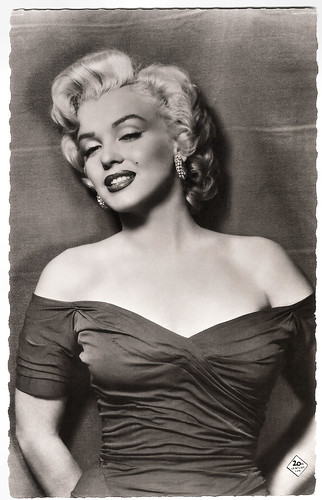
Marilyn Monroe. French postcard by Editions P.I., offered by Les Carbones Korès Carboplane, no. 882. Photo: 20th Century-Fox.

Yul Brynner and Deborah Kerr. British postcard in the Picturegoer Series, London, no. D 880. Photo: 20th Century Fox. Publicity still for The King and I (Walter Lang, 1956).

Jayne Mansfield. German postcard by Filmbilder-Vertrieb Ernst Freihoff, Essen. Retail price: 10 Pfg. Photo: Frank Powolny / Centfox. Publicity still for The Girl Can't Help It (Frank Tashlin, 1956).

Richard Burton and Elizabeth Taylor. German postcard by Filmbilder-Vertrieb Ernst Freihoff, Essen, no. AX 5536. Photo: publicity still for Cleopatra (Joseph L. Mankiewicz, 1963).
With few pictures on the schedule, Skouras wanted to rush Zanuck's big-budget war epic The Longest Day (Ken Annakin, Andrew Marton, a.o., 1962) into release as another source of quick cash. The Longest Day is a highly accurate account of the Allied invasion of Normandy in 1944, with a huge international cast. Skouras's plan offended Darryl F. Zanuck, still Fox's largest shareholder, for whom The Longest Day was a labour of love that he had dearly wanted to produce for many years. Rather than being rushed into release as if it were a B-picture, it was finally released in 1963 at a length of three hours. The Longest Day was well received by the critics and was a box office hit. At the next board meeting, Zanuck spoke for eight hours, convincing directors that Skouras was mismanaging the company and that he was the only possible successor. Zanuck was installed as chairman, and then named his son Richard Zanuck as president.
This new management group seized Cleopatra (Joseph L. Mankiewicz, 1963) and rushed it to completion, shut down the studio, laid off the entire staff to save money, axed the long-running Movietone Newsreel and made a series of cheap, popular pictures that restored Fox as a major studio. The saving grace to the studio's fortunes came from the tremendous success of The Sound of Music (Robert Wise, 1965), starring Julie Andrews. It was an expensive and handsomely produced film adaptation of the highly acclaimed Rodgers and Hammerstein Broadway musical, which became a significant success at the box office and won five Academy Awards, including Best Director and Best Picture of the Year.
Fox also had two big Science-Fiction hits in the 1960s: Fantastic Voyage (Richard Fleischer, 1966) with Stephen Boyd and Raquel Welch, and the original Planet of the Apes (Franklin J. Schaffner, 1968), starring Charlton Heston, Kim Hunter, and Roddy McDowall. The latter film tells the story of an astronaut crew who crash-lands on a strange planet in the distant future. Although the planet appears desolate at first, the surviving crew members stumble upon a society in which apes have evolved into creatures with human-like intelligence and speech. The apes have assumed the role of the dominant species and humans are mute creatures wearing animal skins. Fantastic Voyage (1966) is a Jules Verne-style adventure about a submarine crew who shrink to microscopic size and venture into the body of an injured scientist to repair damage to his brain. It was the last film made in CinemaScope, which was ultimately replaced by Panavision lenses.
The younger Zanuck proved to be an astute executive, working in tandem with David Brown on such contemporary-minded hits as Patton (Franklin J. Schaffner, 1970), M*A*S*H (Robert Altman, 1970) and The French Connection (William Friedkin, 1971) with Gene Hackman. But costly attempts to duplicate the success of The Sound of Music (1965) with Doctor Dolittle (Richard Fleischer, 1967) starring Rex Harrison, and Star! (Robert Wise, 1968) with Julie Andrews, led to expensive flops. Then, in 1970, chairman Zanuck Sr. fired his son and sparked an Oedipal family feud that sucked in Zanuck's ex-wife, former actress Virginia Fox - Richard's mother, a major shareholder - and ended with the elder Zanuck being pushed out of the studio he co-founded, in 1971. Richard Zanuck moved on, and successfully produced The Sting (George Roy Hill, 1973) with Paul Newman and Robert Redford, and Jaws (Steven Spielberg, 1975), the original summer blockbuster.
Following Darryl F. Zanuck’s removal, and after an uncertain period, new management brought Fox back to health. Under president Gordon T. Stulberg and production head Alan Ladd, Jr., Fox films connected with modern audiences. Mel Brooks created a series of showcase comedies. Fox also distributed the cult classic The Rocky Horror Picture Show (Jim Sharman, 1975) featuring Tim Curry. Foreshadowing a pattern of film production still yet to come, in late 1973 Twentieth Century-Fox joined forces with Warner Bros. to co-produce the disaster film The Towering Inferno (John Guillermin, 1974), an action blockbuster from producer Irwin Allen with an all-star cast led by Paul Newman and Steve McQueen. Both studios found themselves owning the rights to books about burning skyscrapers. Allen insisted on a meeting with the heads of both studios and announced that as Fox was already in the lead with their property it would be career suicide to have competing movies. And so the first joint venture studio deal was struck. The film was a critical success, earning a nomination for the Academy Award for Best Picture, and was the highest-grossing film released in 1974. The Towering Inferno (1974) was nominated for eight Oscars in all, winning three. In hindsight whilst it may be common place now, back in the 1970s it was a risky, but revolutionary idea that paid off handsomely at both the domestic and international box offices around the world.
In 1977, Fox's success reached new heights. The studio produced the most profitable film made up to that time, the epic space opera Star Wars (George Lucas, 1977), later retitled Star Wars: Episode IV – A New Hope. Substantial financial gains were realised as a result of the film's unprecedented success: from a low of $6 in June 1976, stock prices more than quadrupled to almost $27 after Star Wars' release; 1976 revenues of $195 million rose to $301 million in 1977. Star Wars (1977), starring Mark Hamill, Harrison Ford, Carrie Fisher, Peter Cushing, and Alec Guinness, received ten Academy Award nominations (including Best Picture), winning seven. It would be the first film in the original Star Wars trilogy and was the beginning of the Star Wars franchise.

Elizabeth Taylor. Belgian postcard by SB (Uitgeverij Best), Antwerpen (Antwerp). Photo: still for Cleopatra (Joseph L. Mankiewicz, 1963).

Julie Andrew. Austrian postcard by MM-Verlag, Salzburg, no. FS 3000. Photo: publicity still for The Sound of Music (Robert Wise, 1965).
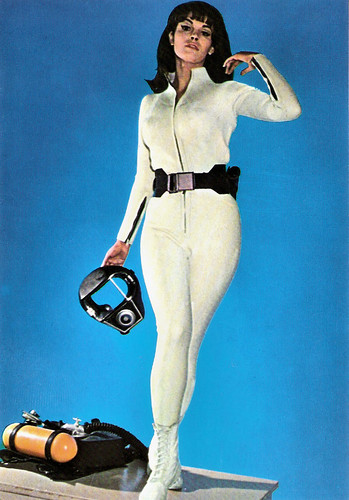
Raquel Welch. British postcard by Klasik Kards, no. 1541. Photo: publicity still for Fantastic Voyage (Richard Fleischer, 1966).

Julie Andrew and Daniel Massey. Italian photo by Rotograph, Roma. Photo: 20th Century Fox. Publicity still for Star! (Robert Wise, 1968).
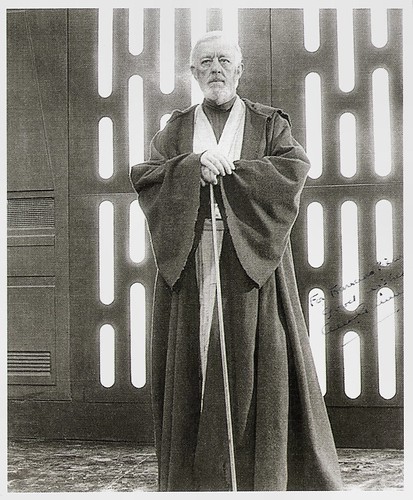
Alec Guinness. British autograph card. Photo; publicity still for <i>Star Wars</i> (George Lucas, 1977).
With financial stability came new owners, when Fox was sold for more than $700 million in 1981 to investors Marc Rich and Marvin Davis. By 1984, Rich had become a fugitive from justice, having fled to Switzerland after being charged by U.S. federal prosecutors with tax evasion, racketeering, and illegal trading with Iran during the Iran hostage crisis. Marvin Davis bought out Marc Rich's 50% interest in 20th Century-Fox Film Corporation. Davis sold this interest to Rupert Murdoch for $250 million in March 1985. The studio had continued success with such films as Romancing the Stone (Robert Zemeckis, 1984) with Michael Douglas, Wall Street (Oliver Stone, 1987), Home Alone (Chris Columbus, 1990), and Speed (Jan de Bont, 1994) starring Keanu Reeves. Titanic (James Cameron, 1997) with Leonardo DiCaprio and Kate Winslet, was the first film to surpass $1 billion at the global box office. Fox also produced the hugely popular Cast Away (Robert Zemeckis, 2000) with Tom Hanks; Lincoln (Steven Spielberg, 2012) with Daniel Day Lewis; and the Alien and Die Hard series. Since 2000, 20th Century Fox has been the international distributor for MGM/UA releases.
In 2009, a newly updated CGI 20th Century Fox logo debuted with the Science-Fiction Epic Avatar (James Cameron, 2009). The film is set in the mid-22nd century, when humans are colonising Pandora, a lush habitable moon of a gas giant in the Alpha Centauri star system. Avatar (2009) opened to positive critical reviews, with critics highly praising its ground-breaking visual effects. During its theatrical run, the film broke several box office records and became the highest-grossing film of all time, as well as in the United States and Canada, surpassing Cameron's Titanic (1997), which had held those records for twelve years. It also became the first film to gross more than $2 billion and was the best-selling film of 2010 in the United States. Avatar was nominated for nine Academy Awards, including Best Picture and Best Director, and won three, for Best Art Direction, Best Cinematography and Best Visual Effects.
20th Century Fox owned the rights to several Marvel Comics series, which were turned into such blockbusters as the X-Men film series, and Deadpool (Tim Miller, 2016) with Ryan Reynolds. Very successful was also the Ice Age animation series, the survival drama Life of Pi (Ang Lee, 2011), and the Western The Revenant (Alejandro G. Iñárritu, 2015). The Revenant, describing frontiersman Hugh Glass's (Leonardo DiCaprio) experiences in 1823, received largely positive reviews, and praise for its performances (particularly from DiCaprio and co-star Tom Hardy), direction, and cinematography. It won three Golden Globe Awards, five BAFTA Awards and 12 Oscar nominations. Iñárritu, DiCaprio, and Emmanuel Lubezki won the awards for Best Director, Best Actor, and Best Cinematography, respectively.
Since 2013 the studio has been a subsidiary of 21st Century Fox. Most recent blockbuster (at time of writing this post) is the superhero film Logan (James Mangold, 2017) starring Hugh Jackman as Wolverine. It is the tenth instalment in the X-Men film series, as well as the third and, currently, final Wolverine solo film. Wikipedia: “Critics praised the film for its screenplay, acting (particularly by Jackman, [Patrick] Stewart, and [Dafne] Keen), Mangold's direction, action sequences, thoughtful tone, themes, departure from traditional superhero films, and emotional depth. It became the best reviewed film in the X-Men series thus far, with some regarding it as one of the greatest superhero films of all time, and it was chosen by the National Board of Review as one of the top ten films of 2017. It was nominated for Best Adapted Screenplay at the 90th Academy Awards, becoming the second superhero film to be nominated for Writing after The Incredibles. It grossed over $619 million worldwide.”
In, 2017, The Walt Disney Company announced plans to purchase 21st Century Fox. On 28 July 2018, Disney and Fox shareholders approved the merger between the two companies. Leonard Maltin: “The fact that 20th Century Fox (now minus the hyphen) is still a powerful, productive studio after more than 80 years is pretty miraculous. But there is one piece of often-overlooked continuity throughout all those decades that is even more remarkable. Alfred Newman composed the world-famous studio fanfare for 20th Century Pictures in 1934. That emblematic theme is still heard at the beginning of nearly every Fox movie. Will that tradition continue under Disney's ownership? Will that fanfare survive the merger? If it doesn't, it will truly be the end of an era.” It did survive.
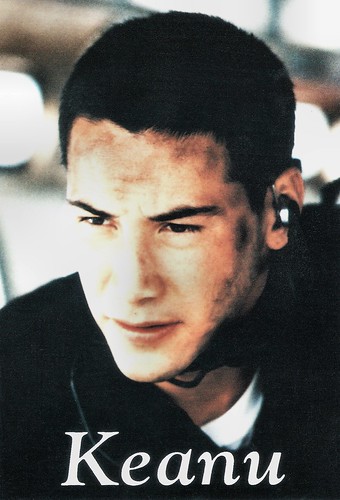
Keanu Reeves. British postcard, no. 2070. Photo: publicity still for Speed (Jan de Bont, 1994).
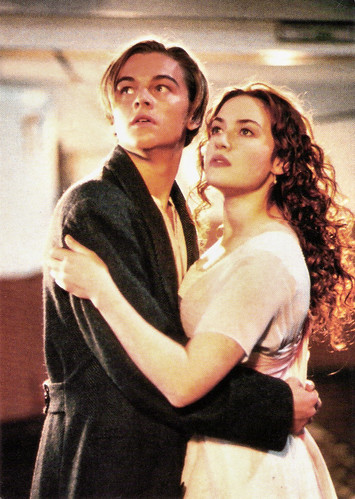
Kate Winslet and Leonardo DiCaprio. German postcard by Sunburst Merchandising GmbH, Osnabrück / Ana Anakos AG, München. Photo: Paramount / Fox, 1998. Publicity still for Titanic (James Cameron, 1997).
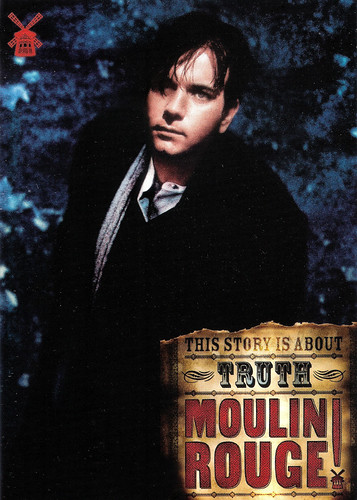
Ewan McGregor. British postcard by Go Card. Photo: 20th Century Fox. Publicity still for Moulin Rouge! (Baz Luhrmann, 2001).
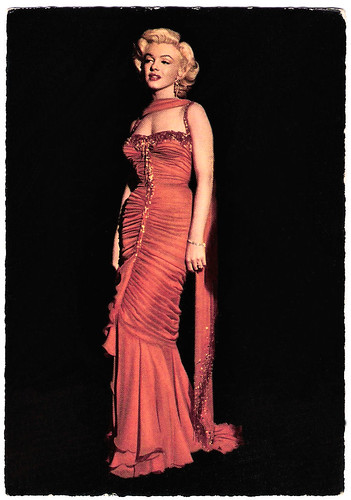
Marilyn Monroe. West-German postcard by Krüger, no. 902/13. Photo: publicity still for Gentlemen Prefer Blondes (Howard Hawks, 1953).
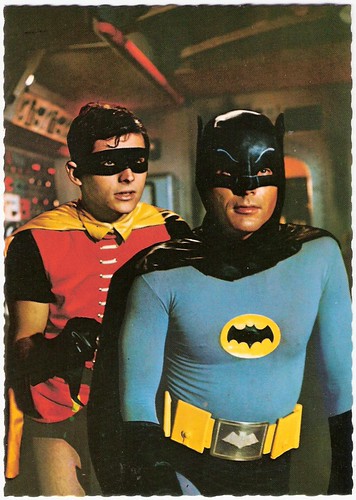
Adam West as Batman / Bruce Wayne and Burt Ward as Robin / Dick Grayson. Dutch postcard by Vita Nova, Schiedam, no. 5. Photo: National Periodical Publications Inc. / 20th Century Fox. Publicity still for Batman (Leslie H. Martenson, 1966).
20th Century Fox Logo History 1914-2015. Source: Sign-offs and Sesame Street Association AVGCP (YouTube).
Sources: Leonard Maltin (The Hollywood Reporter), Encyclopaedia Britannica, and Wikipedia.

Tyrone Power. French postcard, no. 437. Photo: 20th Century Fox.

Annabella. French postcard by Viny, no. 46. Photo: 20th Century Fox.

Sonja Henie. British Postcard by Real Photograph, no. 132. Photo: 20th Century-Fox Pictures.

Simone Simon. British Postcard in the Art Photo series, no. 37-2. Photo: 20th Century Fox, no. 135.

Richard Greene. French postcard by Viny, no. 89. Photo: 20th Century Fox.
Would Daryl F. Zanuck have survived in the #MeToo era?
For many years, 20th Century Fox claimed to have been founded in 1915, the year Fox Film was founded by pioneer William Fox. For instance, it marked 1945 as its 30th anniversary. However, in recent years it has claimed the 1935 merger as its founding, even though most film historians agree it was founded in 1915. 20th Century Fox is known for its searchlight structure logo. Its fanfare was originally composed in 1933 for Twentieth Century Pictures by Alfred Newman, who would become the head of Twentieth Century-Fox's music department from 1940 until the 1960s. It was re-recorded in 1935 when 20th Century-Fox was officially established.
In the early spring of 1935, Twentieth Century Pictures' Joseph Schenck and Darryl F. Zanuck began merger talks with the management of the nearly bankrupt Fox Film, under President Sidney Kent. Spyros Skouras, then manager of the Fox West Coast Theatres, helped make the merger happen, and later became president of the new company. Aside from the theatre chain and a first-rate studio lot, Zanuck and Schenck felt there was not much else to Fox, which had been reeling since the founder William Fox lost control of the company in 1930. The studio's biggest star, Will Rogers, died in a plane crash weeks after the merger. Its leading female star, Janet Gaynor, was fading in popularity and promising leading men James Dunn and Spencer Tracy had been dropped because of heavy drinking.
At first, it was expected that the new company was originally to be called Fox-20th Century, even though 20th Century was the senior partner in the merger. However, 20th Century brought more to the bargaining table besides Schenck and Zanuck; it was more profitable than Fox and had considerably more talent. So, the new Hollywood powerhouse, 20th Century-Fox Film Corporation, began trading on 31 May 1935. The hyphen would be dropped in 1985. Kent remained as President, while Schenck became Chairman and Chief Executive Officer. Zanuck became Vice President in Charge of Production. The company's films retained the 20th Century Pictures searchlight logo on their opening credits as well as its opening fanfare, but with the name changed to 20th Century-Fox.
After the merger was completed, Darryl F. Zanuck brought three stars with him: George Arliss and Loretta Young, from Warners, and Constance Bennett, and he quickly signed young actors who would carry Twentieth Century-Fox for years: Tyrone Power, Linda Darnell, Carmen Miranda, Don Ameche, Henry Fonda, Gene Tierney, and Olympic skater Sonja Henie. Also on the Fox payroll he found two players who he built up into the studio's leading assets, Alice Faye and seven-year-old Shirley Temple. The company established a special training school. Lynn Bari and Patricia Farr were among 14 young women launched for stardom in 1935, when they each received a six-month contract with 20th Century-Fox after spending 18 months in the school. The contracts included a studio option for renewal for as long as seven years. Favouring popular biographies and musicals, Zanuck built Fox back to profitability with light entertainment like Alexander's Ragtime Band (Henry King, 1938) and In Old Chicago (Henry King, 1938), both starring Tyrone Power, Alice Faye and Don Ameche. Twentieth Century–Fox produced mainly Westerns, biopics, religious epics and musicals. The company’s early musicals featured Shirley Temple, but Zanuck was never terribly fond of curly-topped Temple in spite of her enormous popularity.
Leonard Maltin in The Hollywood Reporter: “Zanuck wouldn't have survived in the #MeToo or Time's Up era. He was notorious for taking advantage of starlets. In early 1942, the wiry workaholic, then 40, wangled a commission as a colonel in the U.S. Army Signal Corps and surprised everyone by displaying a hunger to see action. When he returned to Hollywood in mid-1943, he revealed a renewed interest in serious-minded movies, first evidenced in such standout films as Young Mr. Lincoln and The Grapes of Wrath, both directed by John Ford.”
Thanks to record attendance during World War II, Fox overtook RKO and Metro-Goldwyn-Mayer (Hollywood's biggest studio) to become the third most profitable film studio. In 1942, Spyros Skouras succeeded Kent as president of the studio. While Zanuck went off for eighteen months' war service, junior partner William Goetz kept profits high by going for light entertainment. Zanuck always had someone waiting in reserve in case one of his stars became uncooperative. Betty Grable was hired as a threat to musical star Alice Faye and soon surpassed her as Fox's premier attraction and No. 1 pinup. The creamy blonde Grable was 20th Century-Fox’s biggest star of the 1940s.
Together with Skouros, Darryl F. Zanuck intended to make Fox's output more serious-minded. During the next few years, with pictures like The Razor's Edge (Edmund Goulding, 1946) with Tyrone Power as an American pilot traumatised by his experiences in World War I, Gentleman's Agreement (Elia Kazan,1947) with Gregory Peck as a journalist, who poses as a Jew to research an exposé on anti-Semitism, The Snake Pit (Anatole Litvak, 1948) starring Olivia de Havilland as a woman who finds herself in an insane asylum and cannot remember how she got there, and the race drama Pinky (Elia Kazan, 1949), with Jeanne Crain as an African-American girl passing for white. Zanuck established a reputation for provocative, adult films. Despite such successes, however, the studio’s productions were often criticized for lacking the style and excitement of films made by rival studios, notably Warner Brothers and MGM.
Fox specialised in adaptations of best-selling books such as Ben Ames Williams' Leave Her to Heaven (John M. Stahl, 1945), starring Gene Tierney as a femme fatale who entraps a husband (Cornel Wilde) and commits several crimes motivated by her insane jealousy over everything concerning him. Tierney received an Oscar nomination as Best Actress. The film grossed over $5,000,000, Fox's highest-grossing picture of the 1940s. Fox also produced film versions of Broadway musicals, including the Rodgers and Hammerstein films, beginning with the musical version of State Fair (Walter Lang, 1945), starring Jeanne Crain and Dana Andrews. State Fair was the only Rodgers and Hammerstein musical written directly for film. The film introduced such popular songs as It Might as Well Be Spring, which won the Academy Award for Best Original Song.

Gene Tierney. Dutch postcard. Photo: 20th Century Fox.

Shirley Temple. French postcard by Editions et Publications Cinématographiques, no. 107. Photo: Fox-Film.

Betty Grable and Victor Mature. Dutch postcard by Uitg. J. Sleding N.V., Amsterdam, no. 33. Photo: 20th Century Fox. Publicity still for I Wake Up Screaming (H. Bruce Humberstone, 1941).

Betty Grable. Dutch postcard, no. 204. Photo: 20th Century Fox.

Cary Grant. Dutch postcard, no. 3286. Photo: 20th Century Fox. Publicity still for I Was a Male War Bride (Howard Hawks, 1949).
Spyros Skouras' deal that left the other studios empty-handed
After the war, and with the advent of television, audiences slowly drifted away. Twentieth Century-Fox held on to its theatres until a court-mandated ‘divorce’; they were spun off as Fox National Theatres in 1953.That year, with attendance at half the 1946 level, Twentieth Century-Fox gambled on an unproven gimmick. Noting that the two film sensations of 1952 had been Cinerama, which required three projectors to fill a giant curved screen, and Natural Vision 3D, which got its effects of depth by requiring the use of polarised glasses, Fox mortgaged its studio to buy rights to a French anamorphic projection system which gave a slight illusion of depth without glasses. President Spyros Skouras struck a deal with the inventor Henri Chrétien, leaving the other film studios empty-handed. He introduced CinemaScope, a process by which a film is projected on a screen two and a half times as wide as it is high, in The Robe (Henry Koster, 1953). This ground-breaking Biblical Epic tells the story of a Roman military tribune (Richard Burton) who commands the unit that is responsible for the Crucifixion of Jesus.
Zanuck announced in February 1953 that henceforth all Fox pictures would be made in CinemaScope. To convince theatre owners to install this new process, Fox agreed to help pay conversion costs (about $25,000 per screen); and to ensure enough product, Fox gave access to CinemaScope to any rival studio choosing to use it. Seeing the box-office for the first two CinemaScope features, The Robe (1953) and the romantic comedy How to Marry a Millionaire (Jean Negulesco, 1953) starring Betty Grable, Lauren Bacall and the new sensation Marilyn Monroe, Warner Bros., MGM, Universal, Columbia and Disney quickly adopted the process. How to Marry a Millionaire (1953) was a box office success earning $8 million worldwide and $7.5 million domestically, making it Fox's second highest grossing film of that year with The Robe (1953) being the first. How to Marry a Millionaire (1953) was also the fourth highest-grossing film of 1953, whereas Monroe's previous feature Gentlemen Prefer Blondes (Howard Hawks, 1953) with Jane Russell, was the ninth.
In 1956, Fox engaged Robert Lippert to establish a subsidiary company, Regal Pictures, later Associated Producers Incorporated to film B pictures in CinemaScope (but ‘branded’ RegalScope). Fox produced new musicals using the CinemaScope process including Carousel (Henry King, 1956) with Gordon MacRae and Shirley Jones, and The King and I (Walter Lang, 1956) starring Yul Brynner and Deborah Kerr, both film adaptations of Rodgers and Hammerstein stage musicals of the same name. The King and I (1956) was a critical and commercial success, and was nominated for nine Academy Awards, winning five, including Best Actor for Brynner.
CinemaScope brought a brief upturn in attendance, but by 1956 the numbers again began to slide. That year Darryl F. Zanuck announced his resignation as head of production. Zanuck moved to Paris, setting up as an independent producer, seldom being in the United States for many years. President Spyros Skouras brought in a series of production executives, but none had Zanuck's success. The studio wooed Zanuck back for projects more than once, even allowing him to cast his mistresses (Bella Darvi, Juliette Greco, Irina Demick) in leading roles.
However, by the early 1960s, Fox was in trouble. A new version of Cleopatra had begun in 1959 with Joan Collins in the lead. As a publicity gimmick, producer Walter Wanger offered $1 million to Elizabeth Taylor if she would star. She accepted, and costs for Cleopatra began to escalate, aggravated by Richard Burton's on-set romance with Taylor, the surrounding media frenzy, and Skouras' selfish preferences and inexperienced micromanagement on the film's production. Not even his showmanship made up for his considerable lack of filmmaking expertise in speeding up production on Cleopatra.
Meanwhile, another remake - of the Cary Grant screwball comedy My Favorite Wife (Garson Kanin, 1940) - was rushed into production in an attempt to turn over a quick profit to help keep Fox afloat. The romantic comedy entitled Something's Got to Give paired Marilyn Monroe, Fox's most bankable star of the 1950s, with Dean Martin, and director George Cukor. The troubled Monroe caused delays on a daily basis, and it quickly descended into a costly debacle. She was fired, but Dean Martin refused to work with anyone else. So Skouras finally decided that re-signing her was unavoidable, and according to Fox files Marilyn was rehired within weeks for a two-picture deal totalling $1 million, $500,000 to finish Something's Got to Give, plus a bonus at completion, and another $500,000 for another project, What a Way to Go. After Monroe’s death on 5 August 1962, just days before filming was due to resume, Something's Got to Give was abandoned. Most of its completed footage remained shelved for nearly 40 years. Twentieth Century-Fox overhauled the entire production idea the following year with a mostly new cast and crew, for the hit Move Over, Darling (Michael Gordon, 1963) starring Doris Day and James Garner.
As Cleopatra's budget passed $10 million, eventually costing around $44 million, Fox sold its back lot (now the site of Century City) to Alcoa in 1961 to raise cash. Elizabeth Taylor's reign on the Cleopatra set continued unchallenged from 1960 into 1962, though three Fox executives went to Rome in June 1962 to fire her. They learned that director Joseph L. Mankiewicz had filmed out of sequence and had only done interiors, so Fox was then forced to allow Taylor several more weeks of filming. In the meantime that summer of 1962, Fox released nearly all of its contract stars, including Jayne Mansfield. Leonard Maltin in The Hollywood Reporter: “It was believed the wildly expensive epic Cleopatra - which paid Elizabeth Taylor an eye-popping $1 million salary - nearly bankrupted 20th Century Fox, (…). Facts aside, Cleopatra became a scapegoat for all of the studio's ills.”

Richard Burton. British postcard in the Picturegoer Series, London, no. D 459. Photo: 20th Century-Fox. Publicity still for The Robe (Henry Koster, 1953).

Marilyn Monroe. French postcard by Editions P.I., offered by Les Carbones Korès Carboplane, no. 882. Photo: 20th Century-Fox.

Yul Brynner and Deborah Kerr. British postcard in the Picturegoer Series, London, no. D 880. Photo: 20th Century Fox. Publicity still for The King and I (Walter Lang, 1956).

Jayne Mansfield. German postcard by Filmbilder-Vertrieb Ernst Freihoff, Essen. Retail price: 10 Pfg. Photo: Frank Powolny / Centfox. Publicity still for The Girl Can't Help It (Frank Tashlin, 1956).

Richard Burton and Elizabeth Taylor. German postcard by Filmbilder-Vertrieb Ernst Freihoff, Essen, no. AX 5536. Photo: publicity still for Cleopatra (Joseph L. Mankiewicz, 1963).
The Zanuck's Oedipal family feud
With few pictures on the schedule, Skouras wanted to rush Zanuck's big-budget war epic The Longest Day (Ken Annakin, Andrew Marton, a.o., 1962) into release as another source of quick cash. The Longest Day is a highly accurate account of the Allied invasion of Normandy in 1944, with a huge international cast. Skouras's plan offended Darryl F. Zanuck, still Fox's largest shareholder, for whom The Longest Day was a labour of love that he had dearly wanted to produce for many years. Rather than being rushed into release as if it were a B-picture, it was finally released in 1963 at a length of three hours. The Longest Day was well received by the critics and was a box office hit. At the next board meeting, Zanuck spoke for eight hours, convincing directors that Skouras was mismanaging the company and that he was the only possible successor. Zanuck was installed as chairman, and then named his son Richard Zanuck as president.
This new management group seized Cleopatra (Joseph L. Mankiewicz, 1963) and rushed it to completion, shut down the studio, laid off the entire staff to save money, axed the long-running Movietone Newsreel and made a series of cheap, popular pictures that restored Fox as a major studio. The saving grace to the studio's fortunes came from the tremendous success of The Sound of Music (Robert Wise, 1965), starring Julie Andrews. It was an expensive and handsomely produced film adaptation of the highly acclaimed Rodgers and Hammerstein Broadway musical, which became a significant success at the box office and won five Academy Awards, including Best Director and Best Picture of the Year.
Fox also had two big Science-Fiction hits in the 1960s: Fantastic Voyage (Richard Fleischer, 1966) with Stephen Boyd and Raquel Welch, and the original Planet of the Apes (Franklin J. Schaffner, 1968), starring Charlton Heston, Kim Hunter, and Roddy McDowall. The latter film tells the story of an astronaut crew who crash-lands on a strange planet in the distant future. Although the planet appears desolate at first, the surviving crew members stumble upon a society in which apes have evolved into creatures with human-like intelligence and speech. The apes have assumed the role of the dominant species and humans are mute creatures wearing animal skins. Fantastic Voyage (1966) is a Jules Verne-style adventure about a submarine crew who shrink to microscopic size and venture into the body of an injured scientist to repair damage to his brain. It was the last film made in CinemaScope, which was ultimately replaced by Panavision lenses.
The younger Zanuck proved to be an astute executive, working in tandem with David Brown on such contemporary-minded hits as Patton (Franklin J. Schaffner, 1970), M*A*S*H (Robert Altman, 1970) and The French Connection (William Friedkin, 1971) with Gene Hackman. But costly attempts to duplicate the success of The Sound of Music (1965) with Doctor Dolittle (Richard Fleischer, 1967) starring Rex Harrison, and Star! (Robert Wise, 1968) with Julie Andrews, led to expensive flops. Then, in 1970, chairman Zanuck Sr. fired his son and sparked an Oedipal family feud that sucked in Zanuck's ex-wife, former actress Virginia Fox - Richard's mother, a major shareholder - and ended with the elder Zanuck being pushed out of the studio he co-founded, in 1971. Richard Zanuck moved on, and successfully produced The Sting (George Roy Hill, 1973) with Paul Newman and Robert Redford, and Jaws (Steven Spielberg, 1975), the original summer blockbuster.
Following Darryl F. Zanuck’s removal, and after an uncertain period, new management brought Fox back to health. Under president Gordon T. Stulberg and production head Alan Ladd, Jr., Fox films connected with modern audiences. Mel Brooks created a series of showcase comedies. Fox also distributed the cult classic The Rocky Horror Picture Show (Jim Sharman, 1975) featuring Tim Curry. Foreshadowing a pattern of film production still yet to come, in late 1973 Twentieth Century-Fox joined forces with Warner Bros. to co-produce the disaster film The Towering Inferno (John Guillermin, 1974), an action blockbuster from producer Irwin Allen with an all-star cast led by Paul Newman and Steve McQueen. Both studios found themselves owning the rights to books about burning skyscrapers. Allen insisted on a meeting with the heads of both studios and announced that as Fox was already in the lead with their property it would be career suicide to have competing movies. And so the first joint venture studio deal was struck. The film was a critical success, earning a nomination for the Academy Award for Best Picture, and was the highest-grossing film released in 1974. The Towering Inferno (1974) was nominated for eight Oscars in all, winning three. In hindsight whilst it may be common place now, back in the 1970s it was a risky, but revolutionary idea that paid off handsomely at both the domestic and international box offices around the world.
In 1977, Fox's success reached new heights. The studio produced the most profitable film made up to that time, the epic space opera Star Wars (George Lucas, 1977), later retitled Star Wars: Episode IV – A New Hope. Substantial financial gains were realised as a result of the film's unprecedented success: from a low of $6 in June 1976, stock prices more than quadrupled to almost $27 after Star Wars' release; 1976 revenues of $195 million rose to $301 million in 1977. Star Wars (1977), starring Mark Hamill, Harrison Ford, Carrie Fisher, Peter Cushing, and Alec Guinness, received ten Academy Award nominations (including Best Picture), winning seven. It would be the first film in the original Star Wars trilogy and was the beginning of the Star Wars franchise.

Elizabeth Taylor. Belgian postcard by SB (Uitgeverij Best), Antwerpen (Antwerp). Photo: still for Cleopatra (Joseph L. Mankiewicz, 1963).

Julie Andrew. Austrian postcard by MM-Verlag, Salzburg, no. FS 3000. Photo: publicity still for The Sound of Music (Robert Wise, 1965).

Raquel Welch. British postcard by Klasik Kards, no. 1541. Photo: publicity still for Fantastic Voyage (Richard Fleischer, 1966).

Julie Andrew and Daniel Massey. Italian photo by Rotograph, Roma. Photo: 20th Century Fox. Publicity still for Star! (Robert Wise, 1968).

Alec Guinness. British autograph card. Photo; publicity still for <i>Star Wars</i> (George Lucas, 1977).
One of the greatest superhero films of all time
With financial stability came new owners, when Fox was sold for more than $700 million in 1981 to investors Marc Rich and Marvin Davis. By 1984, Rich had become a fugitive from justice, having fled to Switzerland after being charged by U.S. federal prosecutors with tax evasion, racketeering, and illegal trading with Iran during the Iran hostage crisis. Marvin Davis bought out Marc Rich's 50% interest in 20th Century-Fox Film Corporation. Davis sold this interest to Rupert Murdoch for $250 million in March 1985. The studio had continued success with such films as Romancing the Stone (Robert Zemeckis, 1984) with Michael Douglas, Wall Street (Oliver Stone, 1987), Home Alone (Chris Columbus, 1990), and Speed (Jan de Bont, 1994) starring Keanu Reeves. Titanic (James Cameron, 1997) with Leonardo DiCaprio and Kate Winslet, was the first film to surpass $1 billion at the global box office. Fox also produced the hugely popular Cast Away (Robert Zemeckis, 2000) with Tom Hanks; Lincoln (Steven Spielberg, 2012) with Daniel Day Lewis; and the Alien and Die Hard series. Since 2000, 20th Century Fox has been the international distributor for MGM/UA releases.
In 2009, a newly updated CGI 20th Century Fox logo debuted with the Science-Fiction Epic Avatar (James Cameron, 2009). The film is set in the mid-22nd century, when humans are colonising Pandora, a lush habitable moon of a gas giant in the Alpha Centauri star system. Avatar (2009) opened to positive critical reviews, with critics highly praising its ground-breaking visual effects. During its theatrical run, the film broke several box office records and became the highest-grossing film of all time, as well as in the United States and Canada, surpassing Cameron's Titanic (1997), which had held those records for twelve years. It also became the first film to gross more than $2 billion and was the best-selling film of 2010 in the United States. Avatar was nominated for nine Academy Awards, including Best Picture and Best Director, and won three, for Best Art Direction, Best Cinematography and Best Visual Effects.
20th Century Fox owned the rights to several Marvel Comics series, which were turned into such blockbusters as the X-Men film series, and Deadpool (Tim Miller, 2016) with Ryan Reynolds. Very successful was also the Ice Age animation series, the survival drama Life of Pi (Ang Lee, 2011), and the Western The Revenant (Alejandro G. Iñárritu, 2015). The Revenant, describing frontiersman Hugh Glass's (Leonardo DiCaprio) experiences in 1823, received largely positive reviews, and praise for its performances (particularly from DiCaprio and co-star Tom Hardy), direction, and cinematography. It won three Golden Globe Awards, five BAFTA Awards and 12 Oscar nominations. Iñárritu, DiCaprio, and Emmanuel Lubezki won the awards for Best Director, Best Actor, and Best Cinematography, respectively.
Since 2013 the studio has been a subsidiary of 21st Century Fox. Most recent blockbuster (at time of writing this post) is the superhero film Logan (James Mangold, 2017) starring Hugh Jackman as Wolverine. It is the tenth instalment in the X-Men film series, as well as the third and, currently, final Wolverine solo film. Wikipedia: “Critics praised the film for its screenplay, acting (particularly by Jackman, [Patrick] Stewart, and [Dafne] Keen), Mangold's direction, action sequences, thoughtful tone, themes, departure from traditional superhero films, and emotional depth. It became the best reviewed film in the X-Men series thus far, with some regarding it as one of the greatest superhero films of all time, and it was chosen by the National Board of Review as one of the top ten films of 2017. It was nominated for Best Adapted Screenplay at the 90th Academy Awards, becoming the second superhero film to be nominated for Writing after The Incredibles. It grossed over $619 million worldwide.”
In, 2017, The Walt Disney Company announced plans to purchase 21st Century Fox. On 28 July 2018, Disney and Fox shareholders approved the merger between the two companies. Leonard Maltin: “The fact that 20th Century Fox (now minus the hyphen) is still a powerful, productive studio after more than 80 years is pretty miraculous. But there is one piece of often-overlooked continuity throughout all those decades that is even more remarkable. Alfred Newman composed the world-famous studio fanfare for 20th Century Pictures in 1934. That emblematic theme is still heard at the beginning of nearly every Fox movie. Will that tradition continue under Disney's ownership? Will that fanfare survive the merger? If it doesn't, it will truly be the end of an era.” It did survive.

Keanu Reeves. British postcard, no. 2070. Photo: publicity still for Speed (Jan de Bont, 1994).

Kate Winslet and Leonardo DiCaprio. German postcard by Sunburst Merchandising GmbH, Osnabrück / Ana Anakos AG, München. Photo: Paramount / Fox, 1998. Publicity still for Titanic (James Cameron, 1997).

Ewan McGregor. British postcard by Go Card. Photo: 20th Century Fox. Publicity still for Moulin Rouge! (Baz Luhrmann, 2001).

Marilyn Monroe. West-German postcard by Krüger, no. 902/13. Photo: publicity still for Gentlemen Prefer Blondes (Howard Hawks, 1953).

Adam West as Batman / Bruce Wayne and Burt Ward as Robin / Dick Grayson. Dutch postcard by Vita Nova, Schiedam, no. 5. Photo: National Periodical Publications Inc. / 20th Century Fox. Publicity still for Batman (Leslie H. Martenson, 1966).
20th Century Fox Logo History 1914-2015. Source: Sign-offs and Sesame Street Association AVGCP (YouTube).
Sources: Leonard Maltin (The Hollywood Reporter), Encyclopaedia Britannica, and Wikipedia.
No comments:
Post a Comment